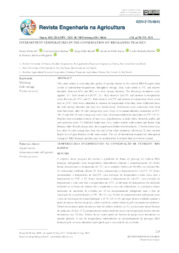Intermittent temperatures in the conservation of "BRS Kampai" peaches.
Intermittent temperatures in the conservation of "BRS Kampai" peaches.
Author(s): NAVROSKI, R.; BARRETO, C. F.; BENATI, J. A.; FARIAS, R. de M.; MARTINS, C. R.; MALGARIM, M. B.
Summary: This study aimed at evaluating the quality of peaches borne by the cultivar BRS Kampai when cooled at intermittent temperatures throughout storage. They were stored at 1°C and relative humidity between 80% and 90% in a cold storage chamber. The following treatments were applied: T1 - fruit stored at 1±0.5°C; T2 - fruit stored at 1±0.5°C and increase in temperature every five days to 25°C; and T3 - fruit stored at 1±0.5°C and increase in temperature every seven days to 25°C. Fruit were submitted to increase in temperature when they were withdrawn from the cold storage chamber and kept in a heated room. Evaluations were conducted when fruit were harvested, after 10 cold storage days and 2 days of commercialization simulation at 25ºC (10+2) and after 20 cold storage days and 2 days of commercialization simulation at 25ºC (20+2). Peaches were evaluated in terms of mass loss, pulp firmness, soluble solids, titratable acidity, pH and epidermis color. T1 exhibited higher mass loss, higher soluble solid content and higher pulp firmness after 20 cold storage days, by comparison with the other treatments. T2 led to lower mass loss after 20 cold storage days than the ones of the other treatments. However, T2 also showed higher loss of pulp firmness in the same period. The use of intermittent temperatures throughout storage of ?BRS Kampai? peaches may be an alternative to extend their post-harvest period.
Publication year: 2021
Types of publication: Journal article
Keywords: Armazenamento, BRS Kampai, Fruticultura, Pêssego, Qualidade, Temperatura
Observation
Some of Embrapa's publications are published as ePub files. To read them, use or download one of the following free software options to your computer or mobile device. Android: Google Play Books; IOS: iBooks; Windows and Linux: Calibre.
Access other publications
Access the Agricultural Research Database (BDPA) to consult Embrapa's full library collection and records.
Visit Embrapa Bookstore to purchase books and other publications sold by Embrapa.

